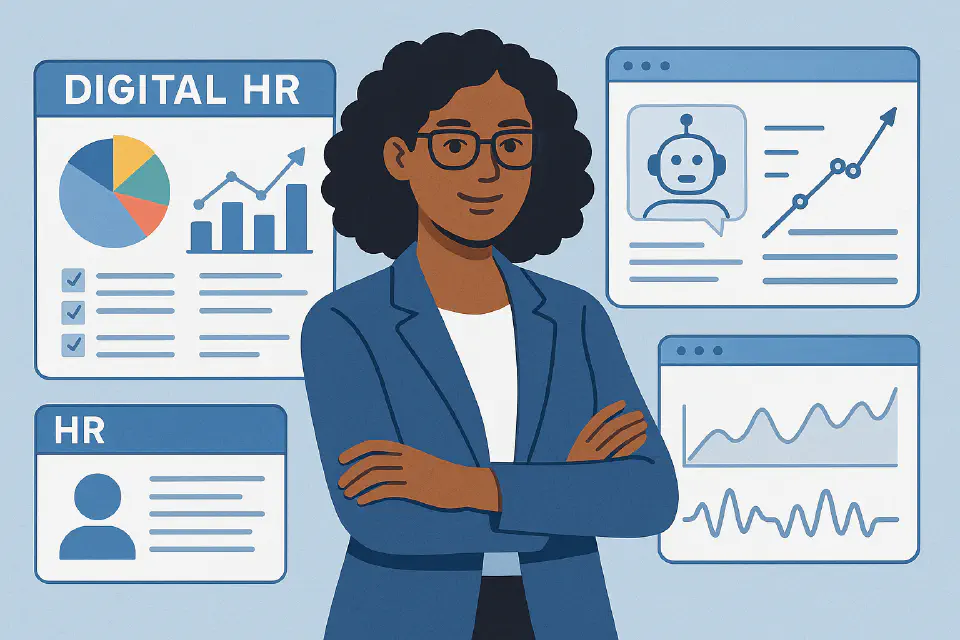
Digital HR & Tools
Digital tools are no longer just a support function in HR—they *are* HR. From analytics dashboards to AI copilots, this section helps you navigate the rapidly evolving digital HR landscape.
Technology is changing the nature of HR faster than ever before. What was once paperwork and gut feeling has transformed into a landscape of cloud-based platforms, predictive dashboards, algorithmic decision-making, and seamless integrations across tools. Whether you’re implementing your first HRIS or building a composable HR tech stack, this section will guide you through the digital building blocks that enable modern, data-driven HR.
What Is Digital HR?
Digital HR refers to the use of technology to support, enhance, and transform Human Resource processes. This includes everything from core systems (like HRIS and ATS) to advanced capabilities such as AI-driven recruitment, real-time people analytics, and digital employee experience platforms (DEXPs).
But Digital HR isn’t just about having tools—it’s about using them strategically. That means selecting the right platforms, ensuring they talk to each other, building a cohesive tech architecture, and using the data they produce to drive smarter decisions.
Why It Matters
Digital HR enables:
- Faster, data-informed decisions
- Personalized employee experiences at scale
- Streamlined operations and reduced admin burden
- Predictive insights into talent risks, engagement, and performance
- Integration of previously siloed HR functions into unified workflows
In a hybrid and remote-first world, having the right digital infrastructure is no longer a competitive advantage—it’s a requirement.
Navigating the Landscape: Core Categories
This section is structured to reflect the real-life digital architecture of HR. We cover:
1. Core HR Platforms
These are the foundational systems that power your day-to-day HR operations.
- HRIS (Human Resource Information Systems): Centralized systems for employee records, benefits, time-off tracking, and more.
- ATS (Applicant Tracking Systems): Tools to manage job postings, candidate pipelines, and recruiting workflows.
- LMS/LXP: Platforms for managing and delivering learning content, tracking progress, and measuring outcomes.
- Feedback Platforms: From pulse surveys to eNPS tools, enabling continuous employee listening.
2. People Analytics & Insights
Turning data into decisions is one of the most impactful shifts in HR today.
We explore:
- Descriptive, predictive, and prescriptive analytics
- People analytics dashboards for HRBPs and leaders
- Flight risk and performance modeling
- Analytics maturity models to benchmark your capabilities
3. Automation & Efficiency Gains
Automation is not about replacing HR—it’s about giving HR professionals more time for strategic work.
Covered topics:
- Workflow automation: Automate onboarding, approvals, and notifications
- RPA (Robotic Process Automation) in high-volume HR tasks
- Chatbots and virtual assistants for employee self-service
4. Artificial Intelligence in HR
AI is moving from buzzword to baseline. In HR, it’s already present in:
- Resume screening and matching
- AI-generated job descriptions
- Performance evaluations
- Learning content recommendations
- AI copilots for HR leaders and recruiters
We also cover critical ethical concerns: fairness, explainability, and algorithmic transparency.
5. Digital Ethics & Governance
As digital tools collect more data, ethics become central. This section addresses:
- Consent and data privacy
- Monitoring vs surveillance boundaries
- Algorithmic bias and explainability
- AI audits and compliance with the EU AI Act
6. HR Tech Strategy & Architecture
Beyond the tools themselves, you need a cohesive tech strategy. We dive into:
- Building a composable HR stack
- Integration middleware (iPaaS)
- Roadmapping and vendor management
- Interoperability across HRIS, ATS, and LMS
- API-first design thinking
7. Emerging Trends & Frontier Tech
Digital HR is evolving fast. Stay ahead with insights into:
- Digital Employee Experience Platforms (DEXP) like Microsoft Viva
- Tech-enabled performance management (e.g., Lattice, Betterworks)
- Blockchain use cases in HR credentialing and identity verification
- Digital Twin of the Organization (DTO) for structural simulation
- SaaS selection and budgeting frameworks
How to Use This Section
Each page is designed to answer key questions:
- What is this tool or technology?
- When and why should I use it?
- What are the risks, trade-offs, and alternatives?
- How do I evaluate or implement it?
- What are best practices in real-world HR teams?
Whether you’re a startup founder picking your first ATS or an enterprise HR strategist redesigning your digital ecosystem, you’ll find practical, grounded insights here.
Final Thoughts
Digital HR isn’t just about transformation. It’s about orchestration—making tools, data, people, and processes work together. This section will help you choose the right systems, avoid common traps, and build a future-ready HR function.
Ready to dive in? Let’s explore the tools shaping the future of work.